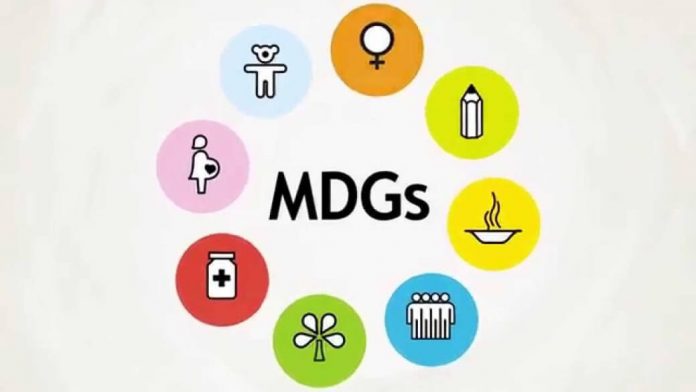This article is written by Seep Gupta, from Institute of Law, Jiwaji University. This is an exhaustive article which deals with the brief study of the United Nations Millennium Declaration 2000.
Table of Contents
Introduction
The United Nations Millennium Declaration was a three-day millennium summit that was held in New York, which is the headquarters of the United Nations, in 2000. The United Nations General Assembly adopted some 60 goals regarding various topics such as related to peace, human rights, environment, development, and others. These goals are known as Millennium Declaration Goals 2000. Another resolution was passed in the United Nations General Assembly 2000 to guide the implementation of the Millennium Development Goals, 2000.
History of Millennium Declaration 2000
The leaders around the world unanimously accepted the United Nations Millennium Declaration 2000, which was held in New York. The main agenda of the United Nation Declaration was the collective efforts to create a shared future and of humanity and broad inclusion of globalization with the indulgence of modern technology to establish the goals such as development, human rights, environment and peace.
It was a 3 days summit and it was one of the largest summits which glorified the presence of the majority of world leaders around the world. This summit was the first summit to be held in the 21st century and its declaration contains the core values, guidelines, effective principles, and strategies to cater to the needs of different agendas in the 21st century. It set the guidelines and strategies for collective action and a shared future.
In the concluding remarks of the summit, Mr Kofi Annan, who was the Secretary-General of the United Nations when this declaration conference was held, said that it is the responsibility of various world leaders to stick to the directions which are given in the summit to adopt the organization as per the needs of the 21st century.
The world leaders took the pledge of upholding the humanity, equality, and spirit of the organization by their keen focus on the most vulnerable groups such as children and the poor.
The leaders around the world accepted that the main challenge ahead of them is to channelize the new technology and to bring out the positive outcome of globalization in the world. The declaration called for the global policies and measures for the developing countries, its finance, and economies in transition.
Freedom, equality, solidarity, tolerance, respect for nature and shared responsibility were the six core and fundamental values that the Millennium Declaration cited.
Values and principles of the United Nations objectives of Millennium Declaration 2000
Values and principles
The objective of the United Nations Millennium Declaration was to reaffirm the faith in the charter of the U.N. and underlying values and principles of the United Nations. The motive of the summit was to flourish the peace, friendship, shared future and to establish the mutual cooperation between the countries.
Apart from the individual responsibility, it’s the collective responsibility of all the world leaders to uphold the dignity, human rights, peace, and mutual friendship.
The millennium summit was held in the first year of the 21st century and the main motive of the summit was to counter and to cope up with the new challenges of the 21st century and to deal with the new technologies. Due to the impact of globalization which was introduced in the late ’90s, the countries have become much more in proximity and interconnection with each other.
The UN Millennium Declaration was determined to uphold the principles of sovereignty, peace, equality and everlasting peace in accordance with the principles mentioned in the United Nations charter. The United Nation supports all efforts to give political freedom and territorial integration to all States, resolution of disputes through peaceful and harmonious ways, right to self-determination, respect for human rights and fundamental freedom, non-interference in the internal affairs of the state and respect of all kinds of rights and no discrimination based on race, sex, and other factors.
Globalization offers immense opportunities and it is one of the diverse ways to connect countries. Globalization should be made fully accessible and equitable and sustainable efforts should be made to unite all the countries of the world for the shared future.
There are some of the basic core fundamental principles that are necessary to establish healthy international relations in the 21st century.
- Freedom– Freedom from violence and hunger is required to guarantee equal rights to both the sexes. Everyone is free to live their lives according to their will. Freedom also ensures the dignity of the children because they are one of the most vulnerable groups.
- Equality– No state or a country can flourish without assuring equal rights to both men and women. Equality of sexes is a very important aspect.
- Solidarity– Global challenges should be met and accomplished in such a way that cost burdens and challenges on poor and underdeveloped countries are avoided. Solidarity and mutual financial assistance are required for it.
- Tolerance– Culture of peace and differences based on genders, races, and ethnicities should neither be repressed nor be feared. They should be respected and cherished because diversity is the asset of human civilization. There should be tolerance between people and mutual respect should be promoted in different communities.
- Respect for nature– Nature must be preserved at every cost. Prudence must be shown and the aim of sustainable development must be promoted to protect the rich natural resources that are provided by nature.
- Shared Responsibility– There should be shared responsibility and cooperation from all the countries in the world to manage economic and social development and all the resources should be mutually shared and exercised globally. The United Nations must play the central role in it as it is one of the most powerful, representative global organizations.
- To accomplish these goals and to convert the values into actions, the millennium submit has provided some key objectives which are given below.
Peace, security and disarmament
Wars have caused much destruction which is why peace should prevail at every cost. The U.N. seeks to eliminate the danger that is posed by the weapons of mass destruction. To avoid war and to promote peace, rule of law such as international law, decisions of the International Court of Justice and guidelines that are given in the charter of the U.N., in case of member countries, these should be strengthened.
Provisions of Chapter VIII of the U.N. should be followed to strengthen the cooperation between the U.N. and other regional organizations. Resources should be provided to the U.N. to promote peace and to avoid conflict, peaceful resolution of disputes, and post-conflict peacebuilding in war-trodden countries.
The main objective of the U.N. is to-
- Maintain international peace and to take mandatory strict action against growing international terrorism. To double the effects to fight with the world drug and trafficking problem.
- To identify the weapons of mass destruction, especially nuclear weapons, and to convene an international conference to identify and eliminate the weapons of mass destruction. To support regional disarmament and to make arms transfer more transparent.
- To support the international Olympic committee to promote peace.
Development and poverty eradication
The United Nations seeks to eliminate the poverty and dehumanizing conditions in which billions of people are living. It seeks to provide an environment to eliminate global poverty and to free the entire human race from the fetters of poverty.
Non-discriminatory multilateral trading and financial systems are required to eradicate poverty along with providing good governance both on regional and on the international level.
The United Nations urges developing countries:
- To develop the speciality index and Barbados program of action to cater to the needs of small developing States.
- It also seeks to half the amount of people who earn only 1 dollar a day till 2015 and to reduce the number of people who do not have access to drinking water by half till 2015.
- To reduce maternal mortality rate and to have access to primary education to all girls and boys equally.
- To reduce the spread of fatal and chronic diseases such as Malaria and HIV AIDS.
- To achieve the goal of ‘cities without slums’ initiative by 2020.
- To promote gender equality and the empowerment of women.
- To combat hunger and poverty are the main goals.
Protection our common environment
The United Nations reaffirm the faith in Agenda 21 given at Rio summit 1992. The UN seeks to-
- Ensure the entry of the Kyoto protocol related to the environment until the 10th anniversary of the UN conference on the environment and on sustainable development in 2002.
- Reduce the emissions of greenhouse gas. To reduce the desertification of sub-Saharan countries.
- Press for the full implementation of the Convention on Biological Diversity.
- Promote and intensify the collective efforts.
- Promote renewable natural resources and sustainable development.
- To stop the waste of water and to promote water conservation strategies both at the regional and national levels.
- Ensure free access to information on the human genome sequence.
Human Rights, democracy and good governance
The United Nations seeks:
- To strengthen and to recognize all the internationally recognized treaties on human rights and rule of law.
- To respect the United Nations Declaration of Human rights.
- To combat discrimination and to enforce the treaty of eliminating all kinds of violence against women.
- To promote greater harmony, tolerance and to ensure and protect the rights of migrant workers, their children, and their families and to eliminate all kinds of racism, xenophobia, and all kinds of discrimination from the society.
- To allow genuine participation in politics and other things of all the citizens actively.
- To ensure the freedom of media and the right of the public to access the information at any time and seeks to promote the transparency of media.
Protecting the vulnerable
Children in armed conflicts, in war zones, genocides, in natural disasters should be given every assistance and protection so that they can lead a normal life. It is important-
- To strengthen international cooperation and to give humanitarian assistance to the countries hosting refugees, internally displaced persons.
- To provide them with safety and security and to smoothly integrate them into societies.
- To give full effects to the treaty, based on the rights of the child including its optional protocols banning illegal prostitution, sale of children, and child pornography.
Meeting the special needs of Africa
The goal is to bring Africa into the mainstream society of powerful countries and-
- To eliminate poverty, hunger, and support sustainable development.
- To give full support to the democracies and internal political structures to different poor African countries.
- To take special measures for poverty eradication, sustainable development and to control the pandemic of HIV and other diseases.
Strengthening the United Nations
In order to strengthen the United Nations, it is important-
- To reaffirm the central position of the General Assembly of the United Nations so that it can play a chief and central role in the policymaking process of the U.N.
- To strengthen the economic and social council and the International court of justice to provide effective implementation of the Charter of the United Kingdom and to provide effective judgment under the rule of law in International affairs.
- To adhere to the major conventions and by adopting best management practices and technologies.
- To ensure greater coordination between the United Nations and its agencies such as Bretton woods institutions, the World Trade Organisation to achieve a fully coordinated approach to the problems of peace and development.
- To give assistance and chance to non- governmental organizations, civil bodies to contribute to the goals and aims of the United Nations.
Millennium Summit
On 17th December 1998, the General Assembly decided to designate the fifty-fifth session of the United Nations General Assembly,‘The Millennium Assembly of the United Nations’ and to convene the Millennium Summit as an integral part of the Millennium Assembly of the United Nations. It was attended by 149 heads of States and governments from 40 countries. In the Millennium Summit, the main document Millennium declaration was adopted which consisted of underlying principles and values which set the agenda for the 21st century. Millennium Summit reaffirmed the faith in the underlying values, principles, and charter of the United Kingdom. And to share the collective responsibility and to uphold the dignity, equality and equity are recognized by the world leaders to protect the most vulnerable group i.e. Children.
Millennium Development Goals (MDGs)
The United Nations Millennium Development Goals were set by the 189 United Nations member States as the set of eight goals that were to be achieved until 2015. It was signed in September 2000 in the presence of the 149 international leaders to combat various things such as hunger, poverty, illiteracy, discrimination against women, and environmental degradation.
Indicators of Millenium Development Goals (MDGs)
The Implementation of these eight Millennium development goals was set to be done from 1st January 2001. The United Nations Millennium Declaration summit will hold these types of summits once in 5 years. The first follow up summit was held in 2005. There are eight sets of goals that are given in the Millennium Development Goals (MDGs)
- To eliminate poverty and hunger.
- To promote maternal health.
- To achieve global primary education in the world.
- To empower women and to promote gender equality by reducing discrimination against women.
- Reduction in child mortality.
- To promote universal partnership.
- To reduce chronic and fatal diseases such as malaria and HIV, AIDS.
- To promote environmental sustainability.
These goals were meant to be achieved until 2015, but most of the goals and targets hadn’t been achieved until 2015. However, a substantive health record was recorded for 15 years.
Progress report on the Health-related MDGs
There is a significant difference between countries in achieving the health-related target that was given in MDGs. The countries who have made the least progress are those who were affected by the high number of HIV AIDS cases, economic hardship and conflict.
Minimum Development Goal 1- To eradicate Poverty and Hunger
Stunting, malnourishment, poor growth, fetal growth restrictions, deficiency of important vitamins and minerals such as iron and zinc, are the major cause of deaths in almost 45% of the kids below the age of 5 years. Between 1990-2013, there has been a drastic reduction in the percentage of underweight children from 28% to 17%. The target was to make it halve between 1990-2015. This rate, however, failed to meet the standards and MDGs goal.
Minimum Development Goal 2- Reduce child mortality
The target was to reduce it by two thirds between the years 1990-2015. In 2013, nearly 6.3 million children died under the age of 5 which is lesser than in 1990 where 12.7 million children died. It has been reduced to half in 2013. The level of immunization in different countries has also increased. The global rate of decline has also accelerated in recent years, still, it is unable and highly unlikely to reach the target till 2015.
Minimum Development Goal 3- Improve maternal health
The goal was to reduce it by three quarters between the years of 1990-2015. To reduce the maternal mortality rate, the premium quality of doctors and health care services are required. The proportion of the births attended by the skilled health care professionals is above 90% in 3 out of 6 WHO regions while it is only 51% in the African region.
However, the UN failed to achieve this target by 2015.
Millennium Development Goal 4- Combat HIV AIDS, malaria and other diseases
The target was till 2010 for universal access to healthcare facilities and treatment of AIDS to all those who need it. New level technologies have reduced the number of AIDS patients. In 2005, the number of AIDS patients was 2.4 million and in 2013 the estimated number of AIDS patients was significantly reduced to 1.5 million. As fewer people are now dying because of HIV AIDS, many people are likely to catch it and continue to live with it.
Overview
There has been a significant reduction in poverty, hunger, discrimination based on gender, race, and other factors. In recent years, there are a lesser number of poor people, maternal mortality rate, underdeveloped malnourished people, and people who are suffering from chronic and fatal diseases such as HIV AIDS. New technologies and many strategic policies and plans of the United Nations on both regional and international levels helped in the significant reduction of these numbers. Still, it is highly unlikely to achieve the targets and goals that have been mentioned in the Millennium Development Goals. The report has been positive till yet.
Conclusion
The United Nations Millennium Declaration main aim is to cope up with new agendas and technologies that are there in the 21st century. New goals were identified and progress reports are positive till yet with the scope of the development. However, it will require the collective efforts and assistance of all the countries of the world to give their contribution in bringing down the targets that are set up in the Millennium Development Goals.
References
- https://www.ohchr.org/EN/ProfessionalInterest/Pages/Millennium.aspx
- https://www.un.org/en/development/devagenda/millennium.shtml
- https://www.un.org/en/events/pastevents/millennium_summit.shtml
- https://www.mdgmonitor.org/millennium-development-goals/
- https://www.who.int/news-room/fact-sheets/detail/millennium-development-goals-(mdgs)
LawSikho has created a telegram group for exchanging legal knowledge, referrals and various opportunities. You can click on this link and join:
 Serato DJ Crack 2025Serato DJ PRO Crack
Serato DJ Crack 2025Serato DJ PRO Crack











 Allow notifications
Allow notifications



